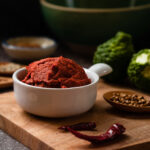✔ Seasons are important – Fresh local ingredients are the heart of Thai cooking and whether it’s the sweet honey that appears only in May or juicy limes in rainy season, what’s on your plate is often dictated by the time of year.
✔ Ingredients age, ingredients change – Many ingredients have different properties and different uses depending on their maturity and ripeness. Take the galangal root for example; when it’s mature it’s found in fiery curry pastes but while still young it’s a staple in aromatic Thai stir-fries.
✔ Flavour at the right time – Making sure the condiments and seasonings go in at just the right time is essential for a delicious Thai dish. Take “Nam Prik Kapi”, the ubiquitous shrimp paste as an example. Thai chefs will pound the shrimp paste with garlic as the first step, as they know that oils released from pounding the garlic will moderate the strong, fishy smell of the shrimps.
✔ Balance is beautiful – Thai food is known for combining the whole spectrum of tastes and flavours in a single dish – sour, sweet, spicy, salty and umami. Nam Prik Kapi, for example, packs a punch with bird’s eye chilis, adds a salty edge with shrimp paste, a splash of sourness with fresh lime and finally, the sweetness of coconut to create a glorious equilibrium of taste.
✔ Aromas and colours play their part – There are no artificial colours or aromas in Thai cooking and it’s not surprising with the abundance of natural ingredients available. Thai people have their ancestors to thank for discovering, developing and handing them down through the generations.
✔Side dishes should be carefully selected – Thai food often comes with a side dish that perfectly complements the flavor, as well as taking the heat out of some of the more potent dishes. Thai Green Curry, for example, is often found served with a salted side dish like salted egg.
✔ A deeper way of eating – The aesthetic qualities of a dish can often elevate it, take “Khanom Cheen Chao Nam” for example. In this dish the rice noodles are soaked with coconut milk and then seasoned with other condiments. Vegetables used to dip in chili paste are also specially selected to give a variety of flavor and textures.
✔ Natural elements should be used to serve – Each of the regions of Thailand has its own unique way of serving up meals in accordance with local culture and traditions and natural materials are often utilized to create utensils. Many dishes are served on a thin piece of banana leaf in order to keep the food clean and retain heat.
Each of these elements is something that Thai people have devoted time and effort to in order to achieve revered status and they are what essentially makes Thai cuisine “The greatest”.
Irin
Source : Thai Food as a Tangible Cultural Heritage, Srisamorn Kongpan, page 114



 Sauce
Sauce Paste
Paste Seasoning
Seasoning